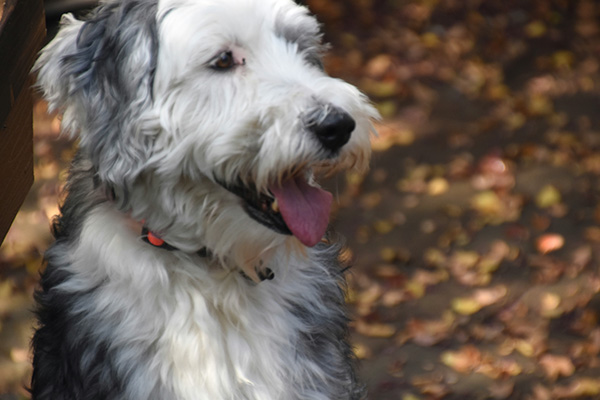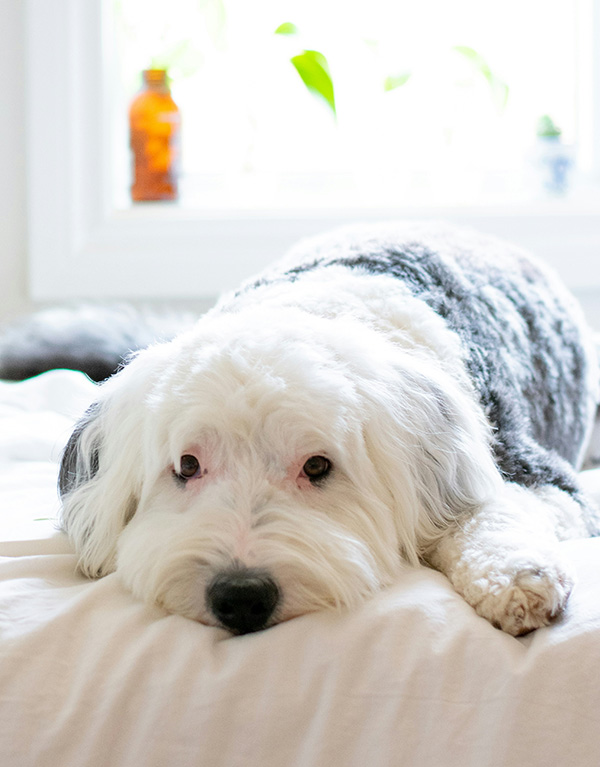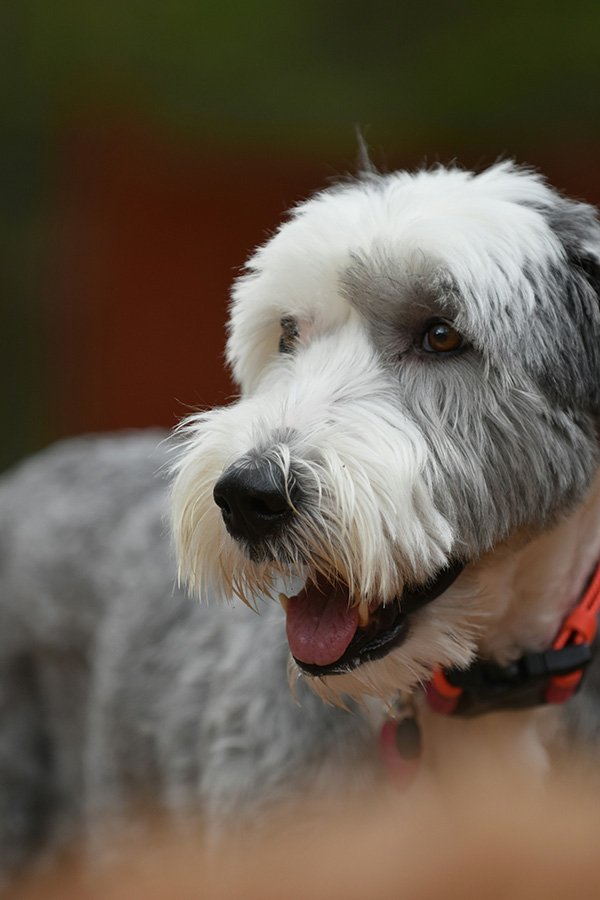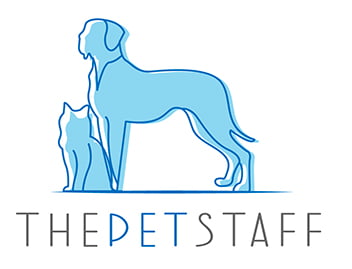Sheepadoodle is a breed that effortlessly combines the intelligence of the Old English Sheepdog with the hypoallergenic charm of the Poodle (standard, miniature, or toy poodle). This fluffy, affectionate hybrid has quickly become a favorite among dog lovers thanks to its playful personality, striking appearance, and versatility. Whether serving as a loyal family companion, a therapy dog, or an energetic playmate, the Sheepadoodle brings joy and warmth to any home.
In this post, we’ll explore everything about this lovable breed—from their origins and unique traits to grooming tips, training advice, and why they might just be the perfect addition to your life.
Breed Characteristics
Temperament | Gentle, playful, affectionate |
Intelligence | high |
Affection/Friendliness | Very friendly and loving |
Trainability | high |
Mental Stimulation | High – obedience, puzzle toys, agility |
Exercise Needs | High – long walks, runs, active play |
Apartment Living | Not suitable |
Family Friendly | yes |
Pet Friendly | Yes, with socialization |
Drooling Level | low |
Energy Level | high |
Loneliness Tolerance | low |
Adaptability | Moderate |
Tendency to bark | Moderate |
Origin
Sheepadoodle originated from the intentional crossbreeding of the Old English Sheepdog and the Poodle. This hybrid breed emerged in the United States in the late 20th century, driven by the increasing demand for low-shedding and hypoallergenic companion dogs. By combining the Poodle's non-shedding coat and high intelligence with the Old English Sheepdog's affectionate and playful nature, breeders aimed to produce a family-friendly dog with desirable traits from both parent breeds. Although not officially recognized by major kennel clubs, this hybrid dog continues to gain popularity and is valued as a beloved companion.

Breed Overview
Height: 18–27"
Weight: 65–85 lbs
Height: 18–25"
Weight: 50–80 lbs
Breed Group
Designer
Life Span
12–15 years
Coat
Wavy or curly
Coat Length
Medium to long
Hypoallergenic
Yes (low-shedding)
Shedding Level
Low to moderate
Size
Sheepadoodles—being a cross between the Old English Sheepdog and Poodle—come in a range of sizes depending on whether they are bred from a standard, miniature, or toy poodle.
- Male Sheepadoodles (Standard): Typically weigh 65–85 pounds and stand 18–27 inches tall at the shoulder.
- Female Sheepadoodles (Standard): Usually slightly smaller, weighing 50–80 pounds and standing 18–25 inches tall.
Mini and toy Sheepadoodles are proportionally smaller, but the same sex-based size differences hold: males trend heavier and taller, while females are leaner and more compact. pounds.
Personality
Sheepadoodles are beloved for their delightful and well-rounded personalities, making them a favorite among families, singles, and even therapy or service work environments. Known for being affectionate, intelligent, and playful, they inherit the best traits from their parent breeds—the Old English Sheepdog and the Poodle. Sheepadoodles are incredibly social dogs that thrive on companionship and building strong family connections. They are recognized for their gentle and patient nature, particularly with children. Being herding dogs, they desired to herd any human or children in the house.
Thanks to their Poodle lineage, these dogs are highly intelligent, making them quick learners and easy to train. They perform well in obedience, agility, and advanced tricks, especially when trained with positive reinforcement. However, their sharp minds require regular mental stimulation to prevent boredom, sometimes resulting in mischievous behavior. Engaging them with puzzle toys, interactive games, and consistent training sessions helps keep them mentally active and well-behaved.
Sheepadoodles have a fun-loving and silly personality, often entertaining their families with their playful antics and cheerful demeanor. They have a fun-loving nature and enjoy activities like fetch, hiking, or simply romping around in the yard. Despite their playful demeanor, they can also be calm and affectionate, often seeking cuddles and companionship from their favorite humans.
While generally friendly and outgoing, Sheepadoodles can sometimes exhibit a protective streak, thanks to their herding instincts from the Old English Sheepdog side. Initially, they might be hesitant around unfamiliar people but usually become friendly once they feel comfortable and secure.
Temperament

The Sheepadoodle’s temperament is one of its most endearing qualities, making it a highly sought-after breed for families, individuals, and even those in need of therapy or service dogs. This hybrid breed combines the finest qualities of its parents, the Old English Sheepdog and the Poodle, creating a loving, intelligent, and highly adaptable companion.
Sheepadoodles are affectionate and sociable dogs that develop strong connections with their families and flourish in human companionship. They are incredibly social dogs that love being involved in family activities, whether it’s a game of fetch in the yard or a cozy evening on the couch.
Sheepadoodles are typically sociable and playful, making them excellent companions for other dogs. They enjoy social interaction and often thrive in multi-dog households or dog park settings. Their playful and affectionate nature makes them well-suited for homes with other pets, but early socialization is crucial to ensure they develop good manners around other dogs.
One of the standout features of the Sheepadoodle’s temperament is its gentle and patient demeanor, especially with children. They have an instinct to nurture and protect, making them great family dogs. Their playful and silly nature adds fun and laughter to any home.
Diet/ Nutritional needs
Sheepadoodles, like all dogs, need a well-balanced diet to support their health, energy, and overall well-being. Their nutritional requirements depend on factors such as size, age, activity level, and any existing health conditions.
A high-quality commercial dog food that meets AAFCO standards is essential, with a high-quality protein source like chicken, beef, or fish listed as the first ingredient. Protein is crucial for muscle development, especially for active breeds like Sheepadoodles, with adult dogs needing at least 18–22% protein and Sheepadoodle puppies requiring 22–32%. Beneficial fats like omega-3 and omega-6 fatty acids, found in sources such as fish oil and flaxseed, help maintain healthy skin and a well-nourished coat—especially important for their dense, often curly fur. Carbohydrates should come from digestible sources like sweet potatoes, brown rice, and vegetables, while vitamins and minerals support overall health, bone development, and immune function.
Portion control is key to preventing obesity, with puppies needing 3 to 4 meals a day and adults thriving on two meals. Special considerations include puppy-specific formulas for the growth of sheepadoodle puppies, lower-calorie diets for seniors, and hypoallergenic options for dogs with sensitivities. Ensure fresh water is always accessible, and keep treats to no more than 10% of their daily calorie intake. Opt for healthy options like carrots or apple slices. Routine veterinary check-ups help monitor and adjust their diet as needed to support their overall health.
Activity/ Exercise needs
Sheepadoodles are lively and energetic dogs that benefit from a combination of physical exercise and mental stimulation to maintain their health and happiness. Typically, they need 60–90 minutes of exercise per day, including walks, playtime, and activities like fetch, hiking, or running in a securely fenced yard.
Mental stimulation is equally important, as Sheepadoodles are highly intelligent and can become bored without challenges, potentially leading to destructive behaviors. Interactive toys, treat-dispensing puzzles, and consistent training sessions are great for keeping their minds engaged. Their intelligence and eagerness to please make them highly skilled in obedience, agility, and learning advanced tricks. Activities like agility training, hiking, and swimming are delightful for this breed, combining physical exercise with mental engagement.
Appearance/ Colors

Sheepadoodles are known for their striking and often eye-catching appearance, blending the best features of their parent breeds. Their looks vary depending on the generation and inherited traits, but they share common characteristics. Sheepadoodles typically have a soft, curly, or wavy coat that ranges from loose waves to tight curls, often thick and plush, giving them a teddy bear-like appearance. Their coats typically range from medium to long and are often low-shedding and hypoallergenic, thanks to their Poodle heritage.
Common color patterns include the classic black-and-white, resembling the Old English Sheepdog, as well as merle (a mottled pattern of black, gray, and white), solid colors (like black or gray), phantom (two-tone with markings), sable (shaded or gradient fur), and parti (predominantly white with patches of another color).
Sheepadoodles come in three sizes—Standard (18–27 inches tall, 50–80 pounds), Medium (16–22 inches tall, 30–50 pounds), and Miniature (14–18 inches tall, 20–35 pounds)—depending on the Poodle parent’s size. They have expressive, almond-shaped eyes that can be brown, blue, or sometimes a mix of both (heterochromatic), along with floppy ears covered in soft, curly fur. With their fluffy coats, round faces, and friendly expressions, Sheepadoodles are often described as oversized teddy bears, each uniquely beautiful and irresistibly charming.
Grooming needs
Sheepadoodles have thick, wavy, or curly coats that require regular grooming to stay clean, tangle-free, and healthy. Their coats are hypoallergenic and low-shedding, but they do require consistent maintenance to prevent matting and keep them comfortable.
Regular brushing is a key part of maintaining a Sheepadoodle’s coat. Their thick fur is prone to tangles, especially in high-friction areas like behind the ears, under the legs, and near the tail. To prevent mats, you should brush your Sheepadoodle at least 3–4 times a week or daily if they have a longer coat. A slicker brush, metal comb, and dematting tool work best for keeping their fur smooth and manageable. To avoid discomfort, brush at the ends of the fur and work toward the skin.
Since Sheepadoodles inherit Poodle-like hair that grows continuously, they require regular trims. Scheduling professional grooming every 6–8 weeks helps maintain a manageable coat length and reduces matting. Common grooming styles include the "Teddy Bear Cut," which creates a rounded, fluffy look, and the "Puppy Cut," which keeps their fur short and evenly trimmed. While at-home trimming is possible, professional grooming ensures an even and polished look.
Bathing is another key part of Sheepadoodle care. Bathing every 4–6 weeks with a mild, hypoallergenic dog shampoo helps prevent skin irritation and keeps their coat clean. After bathing, it’s crucial to dry their fur completely, either with a high-velocity dryer or by towel-drying followed by brushing. This helps prevent matting and keeps it clean and fresh.
Sheepadoodles also need regular ear cleaning to avoid infections, as their floppy ears can hold in moisture and bacteria. Check their ears weekly for signs of redness, odor, or wax buildup. Use a vet-approved ear cleaner and a cotton pad to gently wipe the outer ear, avoiding insertion into the ear canal. Additionally, some Sheepadoodles, especially lighter-colored ones, may develop tear stains. Wiping their eyes daily with a damp cloth or dog-safe eye wipes and trimming the fur around their eyes can help manage this issue.
Nail trimming is another essential part of grooming. Long nails can cause discomfort and affect their walking, so they should be trimmed every 3–4 weeks. If you hear their nails clicking on the floor, it’s time for a trim. Using dog nail clippers or a grinder can help keep their nails at a healthy length.
Dental care should not be overlooked. Brushing their teeth 2–3 times a week with dog-safe toothpaste helps prevent gum disease and bad breath. Providing dental chews or toys can also aid in keeping their teeth clean.
Between grooming sessions, it's important to maintain their coat by keeping it dry after walks in the rain, trimming fur around their paw pads to prevent slipping, and checking for fleas and ticks, especially in warmer months.
Adaptability
Sheepadoodles are incredibly adaptable and can thrive in different living environments. Whether in a large home with a yard or a cozy apartment, they do well if they get plenty of exercise and mental engagement. Their intelligence, inherited from their Poodle and Old English Sheepdog parents, allows them to learn quickly and adapt to new environments, routines, and family dynamics.
These dogs thrive in city and rural settings but do best with an active family that provides regular exercise and socialization. Sheepadoodles are loving and playful, making them wonderful companions for families with children. However, they can also thrive in quieter homes with singles or seniors. Since they are highly social dogs, they may struggle with separation anxiety if left alone for too long, so they do best in households where they receive plenty of attention.
Their dense coat helps them to stay in colder weather well, but in warmer climates, they require special care to avoid overheating. With proper training, exercise, and companionship, Sheepadoodles prove to be highly adaptable and loving pets in nearly any environment.
Trainability

Sheepadoodles are highly trainable dogs, thanks to their intelligence and eagerness to please. As a mix between the Poodle and Old English Sheepdog, both known for their smarts and working-dog instincts, Sheepadoodles pick up commands quickly and excel in obedience training. Their problem-solving abilities make them adaptable to various training methods, including positive reinforcement, which best encourages good behavior.
Life expectancy
Sheepadoodles generally live between 12 and 15 years, depending on factors like genetics, diet, exercise, and overall health care. Smaller Sheepadoodles, such as Mini Sheepadoodles, may live slightly longer, sometimes reaching 14–16 years. As a mixed breed, Sheepadoodles may experience hybrid vigor, potentially making them healthier than their purebred ancestors.
Cost
The price of a Sheepadoodle puppy depends on factors like the breeder's reputation, location, size, coat color, and unique markings. On average, prices range from $1,000 to $4,000 from sheepadoodle breeders. For instance, standard Sheepadoodles are typically priced between $1,200 and $1,800, while Mini and Micro Minis can range from $2,000 to $3,500, depending on their markings and sizes. Certain breeders may set higher prices for Sheepadoodles for rare markings, such as merle, tri-color, red, and blue eyes.
Potential Health Issues
Sheepadoodles are typically healthy, but like any breed, they may be susceptible to certain medical conditions. As a mix of Poodles and Old English Sheepdogs, they can inherit health issues from either lineage. Understanding these potential risks helps owners proactively ensure their dogs' well-being.
Hip Dysplasia
Hip dysplasia is a frequent condition in larger dog breeds, including the Old English Sheepdog and Poodle, making Sheepadoodles susceptible to this condition. This condition arises when the hip joint does not align correctly with the socket, resulting in instability, discomfort, stiffness, and trouble walking. Over time, it can lead to arthritis, affecting the dog's mobility and overall quality of life. Keeping your Sheepadoodle dog at a healthy weight, providing regular but low-impact exercise, and supplementing with joint-supportive nutrients like glucosamine and chondroitin can help manage this condition. In more serious cases, surgery may be required to address the problem.
Bloat (Gastric Dilatation-Volvulus - GDV)
Bloat is a serious and potentially fatal condition in which the stomach fills with gas, fluid, or food and then twists, disrupting digestion and blood circulation. Large, deep-chested breeds, including Sheepadoodles, are at a higher risk of developing this condition. Bloat can lead to shock and organ failure if not treated immediately. To avoid the risk, owners should provide several smaller meals throughout the day rather than one large serving, avoid exercise right after eating, and use a slow feeder bowl to encourage slower eating. In high-risk dogs, a preventive gastropexy surgery may help reduce the likelihood of bloat.
Progressive Retinal Atrophy (PRA)
Progressive Retinal Atrophy is a genetic eye condition that causes gradual vision loss and, in severe cases, can lead to blindness. It is more common in Poodles, meaning Sheepadoodles may be at risk. Symptoms may develop later in life, making early screening crucial. Although there is no cure, regular eye exams can help detect PRA early. Environmental adjustments, such as keeping the layout of your home consistent and using night lights, can help visually impaired dogs navigate more comfortably. Genetic testing can identify disease carriers, making it an important consideration for breeders.
Addison’s Disease
Addison’s disease is a hormonal condition that arises when the adrenal glands fail to produce enough cortisol, a key hormone involved in metabolism and stress management. It is more common in Poodles, making Sheepadoodles genetically predisposed. Addison’s disease can be challenging to diagnose as its symptoms often resemble other conditions. Signs to watch for include lethargy, vomiting, diarrhea, weight loss, and increased thirst. While there is no known prevention, Addison’s disease can be managed with lifelong hormone replacement therapy, allowing affected dogs to live normal, healthy lives. Routine blood tests and monitoring help detect Addison’s before a crisis occurs.
Hypothyroidism
Hypothyroidism occurs when the thyroid gland produces insufficient hormones, resulting in a slowed metabolism. It is common in both Poodles and Old English Sheepdogs, meaning Sheepadoodles are at risk. Signs of hypothyroidism include weight gain despite no increase in appetite, lethargy, dry or flaky skin, hair loss, and cold intolerance. Routine blood tests can diagnose hypothyroidism early, and it is easily treatable with daily thyroid medication, which helps maintain normal hormone and energy levels in affected dogs.
Ear Infections
Sheepadoodles are more susceptible to ear infections due to their floppy ears because moisture and debris can get trapped inside the ear canal. These infections may cause pain, swelling, and even hearing loss if not addressed. Owners should clean their Sheepadoodle’s ears weekly using a vet-approved ear cleaner and always dry them thoroughly after bathing or swimming. Signs of infection include head shaking, redness, foul odor, and ear scratching. Prompt veterinary treatment with medicated ear drops is usually required if an infection occurs.
Skin Allergies & Sensitivities
Sheepadoodles can develop skin allergies due to their thick coats, environmental factors, or food sensitivities. Allergies can cause itching, redness, hot spots, and excessive licking or scratching. To manage this, owners should use a high-quality, limited-ingredient diet if food allergies are suspected. Routine grooming helps remove allergens from the coat, and a vet may recommend hypoallergenic shampoos or medicated treatments. Identifying and eliminating allergens, whether from food, grass, or household products, can significantly reduce skin irritation.
Heart Conditions
Certain Sheepadoodles may be prone to heart conditions like dilated cardiomyopathy (DCM), a disease that causes the heart to enlarge and weaken over time. If left untreated, it can result in heart failure. Signs to be aware of include coughing, breathing difficulties, fatigue, and occasional fainting. Routine veterinary heart screenings can help detect early signs of heart disease. A diet rich in taurine, an essential amino acid for heart health, may help prevent some cases of DCM. In some instances, medications and lifestyle adjustments can help support heart function and improve a dog's quality of life.
